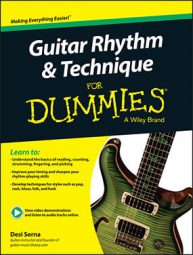You can produce harmonics in a variety of ways on the guitar. To begin, you take a look at the nodes on an open string, which are the locations of what guitarists call natural harmonics. The first node you work with is found at the 12th fret. When you play an open string on your guitar, but graze it gently over the 12th fret while in the process, you chime a harmonic that is one octave higher than the open string’s frequency.
When a harmonic has been produced, immediately remove your fret-hand finger. If you continue to graze the string, then you prevent it from ringing and sustaining properly.
Below you see harmonics at the 12th frets of all six strings, first played individually, then strummed all together as a chord.
In notation, guitar harmonics are symbolized using diamond shapes. Look at the standard notation in below and notice that the note heads are not ovals, but diamonds. Additionally, the tab features the fret numbers in angle brackets, which indicates that they aren’t fretted in the normal manner.
Like the fretted notes at the 12th fret, the harmonics are exactly one octave higher than the same strings open.

Next, you arpeggiate an open E-minor chord, substituting harmonics at the 12th fret for open strings in the second measure. “Nothing Else Matters” by Metallica, which is also in 6/8 time, does something similar beginning at 0:27.

The next node is located at the seventh fret, and you can play natural harmonics across all six strings. In this location, the frequencies are an octave higher than the pitches normally played at the same fret. This means that the 7th fret harmonics actually match the pitches you fret at the 19th fret.

Next, you use harmonics at the 12th and 7th frets in a manner similar to the opening of U2’s “Pride (In the Name of Love).”

Between the 12th and 7th frets, you find scale tones related to the E-minor/G-major pentatonic. You can ascend this scale starting with an A harmonic at the 12th fret of the fifth string, and ending on an E harmonic at the 12th fret of the first string. As you work your way through the scale, you alternate between harmonics at the 12th and 7th frets. In the second half of the figure, you reverse your direction and descend the scale.
Beginning at 1:07 in his guitar instrumental rendition of “Vincent” based in the key of G, Chet Atkins plays the main melody by starting with a harmonic at the 12th fret of the fourth string, ascending the scale using harmonics, and then ending at the 12th fret of the second string.
If you want to play the E-minor pentatonic scale beginning on E and mostly using harmonics, play an E harmonic at the 12th fret of the sixth string first, follow it with the third string, G, open, then pick up where the figure below begins. If you want to start on G, then play the open third string, G, first and then pick up the figure from there.

Below, you play harmonics at the next commonly used node, the fifth fret. In this location, the frequencies are two octaves above the open string pitches, or one octave above the harmonics at the 12th fret. If you have a 24-fret guitar, then the pitches at the highest frets match the harmonics at fret 5 (you can chime the same harmonics at the 24th fret, too).
Harmonics at the 12th and 5th frets have the same note names as the same strings open. The 12th-fret harmonics are one octave above the open strings, and the 5th-fret harmonics are two octaves above the open strings. Seventh-fret harmonics are an octave higher than the fretted notes in the same fret.

The example below combines harmonics at frets 12, 7, and 5. In this example, you essentially play an Em triad inversion at the 12th fret (G–B–E), a Bm triad inversion at the 7th fret (D–F♯–B), and an Em triad inversion again but an octave higher at the 5th fret.

Other useful natural harmonics are found at the ninth fret, at the fourth fret, and slightly behind the third fret. Below, you outline an A7 chord by playing natural harmonics along the fifth string. You first play the root, A, at the 12th fret; followed by the major third, C♯, at the 9th fret; the 5th, E, at the 7th fret; the root, A, again but an additional octave higher at the 5th fret; the very same major third from the 9th fret but now at the 4th fret; and finally, a flat seventh, G, located at approximately fret 2.7, which is slightly behind the 3rd fret.
The same intervals from above, 1–3–5–b7, can be played as harmonics on all strings by using the same fret locations. In other words, you can outline a D7 on the D string, a G7 on the G string, and so on. In fact, you can even squeeze out the intervals 1–3–5–b7 by playing harmonics in between frets 5 and 2.7. Just start at the fifth fret and move back slowly from there as you continue to pick the string. You’ll hear the pitches change.
The harmonics below the fifth fret are weaker than the others and difficult to hear. You can compensate for this by using an electric guitar at a high volume and with added distortion.

For examples of using harmonics below the fifth fret, listen to the beginning of Joe Satriani’s “Summer Song,” U2’s “In God’s Country,” and the guitar solo at 4:28 in Rush’s “Subdivisions.”

